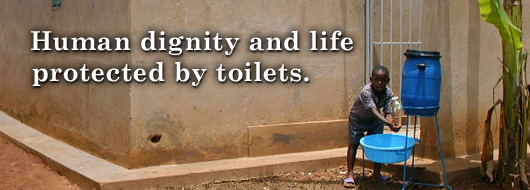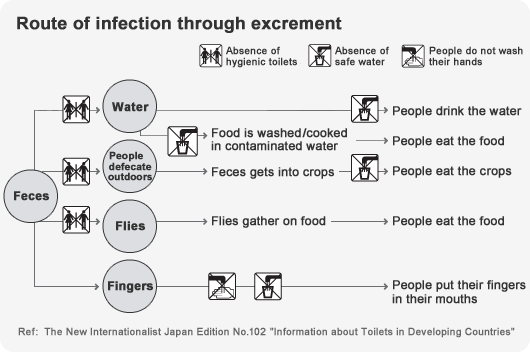No.25 1 Aug. 2009
Human dignity and life protected by toilets.

INDEX
- P1 Human dignity and life protected by toilets.
- P2
“Water” aid progresses but “Toilet” aid is slow off the mark.
In our world, as many as 2.6 billion people live without a toilet. If there is no toilet, should a person do his/her business outside?
What if infectious diseases carried by stools have deleterious effects on children’s health and may even kill them…….
People must eat in order to live. After they have eaten, they must also eliminate wastes. On average, a person eliminate approximately 100 g of feces and 1.5 L of urine each day. In Japan, when we want to go to the toilet, we can excrete wastes at hygienic lavatories located in our homes, places of work, restaurants and bars or public facilities. However, about 40 % of the world’s people live without a hygienic toilet in their lives.
Children who die from diarrhea.
Maybe there are some people who think that we can live without toilets. According to UNICEF, however, inadequate hand washing and insufficient access to clean water and hygienic toilets are the reasons for approximately 90 % of diarrhea cases. And two million children under the age of five die annually due to diarrhetic diseases.
One of the causes of diarrhea is infectious disease such as dysentery and parasitism. These diseases spread when people who are carrying pathogens defecate close to a water source such as a well, contaminating the water. Other people then drink that contaminated water or use it to wash food or cook. Diseases that are rampant in the developing world are often termed “water-borne diseases” however the expression “feces-borne diseases” may equally be used. In other words, in order to inhibit the spread of diarrhetic diseases in developing nations, not only safe water, but also hygienic toilets, are required.

They are ashamed and so they don’t attend school.
Toilets play an important role in protecting the lives and health of people in developing countries. They also exert an immeasurable impact on aspects of people’s daily lives.
For example, there are cases where girls cease to attend school due to the absence of a toilet. As there is no toilet at the school, adolescent girls may have to do their business outside or, if there is a toilet, it may only be a simple toilet surrounded by a bamboo fence and male and female toilets may not be segregated. For reasons such as these, some girls are embarrassed to go to the toilet. Therefore, some girls no longer wish to attend school and their parents may make them to stay home from school. In some cases, as soon as a girl begins to menstruate, her parents no longer allow her to attend school.
There are even a large number of women and girls who, as there are no toilets at school, hold on all day, getting up early before the sun rises and going to the toilet somewhere outside in a remote place. As a result, some of these women become victims of violence and abuse. Women suffer from anxiety about protecting themselves and they are also exposed to the risks of infectious diseases of the urethra and chronic constipation.
The unspoken need for toilets.
Increasing the number of toilets will thus not only protect human health but also promote female dignity and school attendance by girls. Unfortunately, however, public discussion of the subject of going to the toilet is viewed as a taboo in a large number of countries and regions, making it difficult to raise the subject of lavatories.
Even in Japan, we often hear stories about school children who damage their health by holding off from relieving themselves because they feel embarrassed about defecating in school lavatories. As the subject of going to the toilet is a difficult one to talk about both in the developing countries that receive aid and the developed countries who provide it, it has continued to be given a back seat even in terms of the public works carried out by government in developing countries and in aid by developed countries.
NEXT “Water” aid progresses but “Toilet” aid is slow off the mark.
-
- 1
- 2
